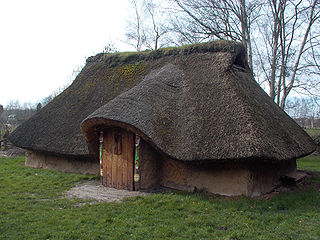Related Research Articles
The Atrebates were a Belgic tribe of the Iron Age and the Roman period, originally dwelling in the Artois region.

The Menapii were a Belgic tribe dwelling near the North Sea, around present-day Cassel, during the Iron Age and the Roman period.

The Bellovaci were a Belgic tribe dwelling in the modern Picardy region, near the present-day city of Beauvais, during the Iron Age and the Roman period. After they were defeated by Caesar in 57 BC, they gave lukewarm support to the Gallic revolt led by Vercingetorix in 52 BC. The Bellovaci nonetheless organized resistance against Rome in 51 BC.

The Suessiones were a Belgic tribe, dwelling in the modern Aisne and Oise regions during the La Tène and Roman periods.
The Viducassēs were a Gallic tribe dwelling in the modern Calvados department during the Iron Age and the Roman period.

The Morini were a Belgic coastal tribe dwelling in the modern Pas de Calais region, around present-day Boulogne-sur-Mer, during the Iron Age and the Roman period.

The Vellavii were a Gallic tribe dwelling around the modern city of Le Puy-en-Velay, in the region of the Auvergne, during the Iron Age and the Roman period.

The Aulerci Cenomani were a Gallic tribe dwelling in the modern Sarthe department during the Iron Age and the Roman period. The Cenomani were the most powerful of the Aulerci tribes.

The Bodiocasses or Baiocasses were an ancient Gallic tribe of the Roman period. They were a tribal division of the civitas of the Lexovii, in the Roman province of Gallia Lugdunensis.
The Abrincatui were a Gallic tribe dwelling in the south of the Cotentin Peninsula during the Roman period.

The Mediomatrici were according to Caesar a Gaulish tribe at the frontier to the Belgicae dwelling in the present-day regions Lorraine, Upper Moselle during the Iron Age and the Roman period.

The Parisii were a Gallic tribe that dwelt on the banks of the river Seine during the Iron Age and the Roman era. They lived on lands now occupied by the modern city of Paris, whose name is derived from the ethnonym.
The Caletes or Caleti were a Belgic or Gallic tribe dwelling in Pays de Caux, in present-day Normandy, during the Iron Age and the Roman period.

The Eburovīcēs or Aulercī Eburovīcēs were a Gallic tribe dwelling in the modern Eure department during the Iron Age and the Roman period. They were part of the Aulerci.

The Ambiani were a Belgic coastal tribe dwelling in the modern Picardy region during the Iron Age and Roman periods.

The Redones or Riedones were a Gallic tribe dwelling in the eastern part of the Brittany peninsula during the Iron age and subsequent Roman conquest of Gaul. Their capital was at Condate, the site of modern day Rennes.
The Tricasses were a Gallic tribe dwelling on the upper Seine and the Aube rivers during the Roman period. Until the first century AD, they were probably reckoned among the Senones.

The Gabali were a Gallic tribe dwelling in the later Gévaudan region during the Iron Age and the Roman period.

The Cadurci were a Gallic tribe dwelling in the later region of Quercy during the Iron Age and the Roman period.
The Catalauni were a Belgic tribe dwelling in the modern Champagne region during the Roman period. The Catalauni probably belonged to a larger tribe, either the Remi in the north or the Lingones in the south. The Catuvellauni, who migrated to southern Britain in the 1st century BC, are likely part of the same tribal group.
References
- ↑ Pliny. Naturalis Historia, 4:106.
- ↑ Ptolemy. Geōgraphikḕ Hyphḗgēsis, 2:9:6.
- ↑ Notitia Dignitatum , oc 42:42.
- ↑ Falileyev 2010, s.v. Silvanectes.
- 1 2 3 Wightman 1985, p. 27.
- 1 2 3 Nègre 1990, p. 157.
- ↑ Delamarre 2003, p. 270.
- Bibliography
- Delamarre, Xavier (2003). Dictionnaire de la langue gauloise: Une approche linguistique du vieux-celtique continental. Errance. ISBN 9782877723695.
- Falileyev, Alexander (2010). Dictionary of Continental Celtic Place-names: A Celtic Companion to the Barrington Atlas of the Greek and Roman World. CMCS. ISBN 978-0955718236.
- Nègre, Ernest (1990). Toponymie générale de la France. Librairie Droz. ISBN 978-2-600-02883-7.
- Popineau, Jean-Marc (2020). "Les Sulbanectes, une approche archéogéographique (Vᵉ s. avant notre ère - Ier s. après)". Compte-rendus et Mémoires de la Société d'Histoire et d'Archéologie de Senlis 2016-2017. p. 11–41.
- Wightman, Edith M. (1985). Gallia Belgica. University of California Press. ISBN 978-0-520-05297-0.
